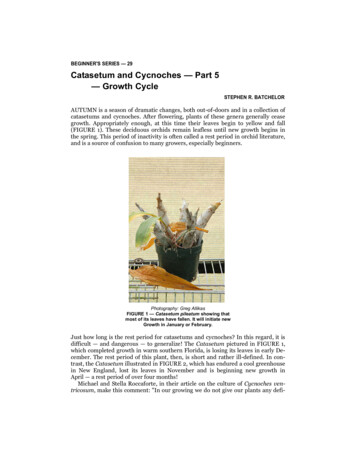
Transcription
BEGINNER'S SERIES — 29Catasetum and Cycnoches — Part 5— Growth CycleSTEPHEN R. BATCHELORAUTUMN is a season of dramatic changes, both out-of-doors and in a collection ofcatasetums and cycnoches. After flowering, plants of these genera generally ceasegrowth. Appropriately enough, at this time their leaves begin to yellow and fall(FIGURE 1). These deciduous orchids remain leafless until new growth begins inthe spring. This period of inactivity is often called a rest period in orchid literature,and is a source of confusion to many growers, especially beginners.Photography: Greg AllikasFIGURE 1 — Catasetum pileatum showing thatmost of its leaves have fallen. It will initiate newGrowth in January or February.Just how long is the rest period for catasetums and cycnoches? In this regard, it isdifficult — and dangerous — to generalize! The Catasetum pictured in FIGURE 1,which completed growth in warm southern Florida, is losing its leaves in early December. The rest period of this plant, then, is short and rather ill-defined. In contrast, the Catasetum illustrated in FIGURE 2, which has endured a cool greenhousein New England, lost its leaves in November and is beginning new growth inApril — a rest period of over four months!Michael and Stella Roccaforte, in their article on the culture of Cycnoches ventricosum, make this comment: "In our growing we do not give our plants any defi-
nite rest. One simple reason is there is always some activity, cither full growth, primary blooming flower spikes, secondary flower spikes, smaller maturing pscudobulbs or the starting of new growth." (Roccaforte, 1974, page 394) Their plantsexperience ideal conditions, with minimum temperatures never below 60 F (16 C).The plant of Cycnoches chlorochilon in FIGURE 4, on the other hand, lost its leavesafter flowering in early March and is pictured resuming active growth in late June.This plant experienced temperatures often in the low 50's F (10-13 C) throughoutthe winter and into spring.Photography: Stephen BatchelorFIGURE 3 — Despite a prolonged rest period, theroot system of this Catasetum expansum is aliveand healthy. Note how readily these roots havebranched.Photography: Stephen BatchelorFIGURE 2 — Catasetum expansum, after beingleafless for over four months begins new growthin AprilApparently, the duration of the rest period for catasctums and cycnoches is determined in large part by the prevailing growing conditions. Plants of these generagrown under optimum conditions, in particular warm temperatures, have a momentary period of leafless inactivity after flowering before new growth begins inearnest. Plants grown under less than ideal conditions, especially under cool temperatures, are far more likely to have a pronounced and lengthy rest period.During their rest period, whatever its length, do catasetums and cycnoches losetheir roots as well as their leaves? Not naturally! The root systems of the plants pic-
tured in FIGURES 3 and 4 are intact and viable, despite the fact that the plants theysupport had been inactive for months. The root systems of catasctums and cycnoches in general resume growth at about the same time the new growth begins. Theroot system illustrated in FIGURE 4, at least a year old, has begun growing again,as is indicated by the greenish-yellow root tips (below those of the new growth itself).Photography: Stephen BatchelorFIGURE 4 — Cycnoches chlorochilon resumesgrowth in June after three months of inactivity.Rest period should not be confused with dormancy. Pterostylis pedunculata, one ofthe Australian "Greenhoods", is an example of one of the few orchids in cultivationwhich truly go dormant. In order to survive the long dry season of its native land,this species loses both its leaves and roots, forming pea-like tubers. Even in thisdormant state, however, some moisture is necessary to avoid desiccation (Thocrlc,1982). It only follows that catasetums and cycnoches, though lacking in leaves during their rest period, still have pseudobulbs and roots which require some water tomaintain their succulence. Without adequate moisture, the pseudobulbs may crack(FIGURE 2) or shrivel, and the roots may dry out and die. Towards the other extreme, too much water during this period of inactivity and reduced transpirationcan result in smothered, rotted roots.Catasetums and cycnoches arc by nature vigorous growers. Even if, for one reasonor another, much or all of a plant's root system is lost during a rest period, the newgrowth to follow, given proper culture, will produce a new root system capable ofsupporting the entire plant. The root system pictured in FIGURE 4 was entirelyproduced in one year. Before that, the plant consisted of a single, rootless pseudobulb. It appears that the natural longevity of Catasetum and Cycnoches roots is determined by the lifespan of the pscudobulb which produced them. Cycnoches pseu-
dobulbs, and their roots, rarely last over three years, while those of Catasetum canlast much longer.Soon after new growth initiates on catasetums and cycnochcs in the spring, thenew roots follow in great profusion (FIGURE 4). From this point on, growth is astonishingly rapid. The new growth elongates at first, then begins leafing out as theroots penetrate and spread within the medium (FIGURE 5). During this phase ofrapid expansion, the growth is tender and vulnerable, and is susceptible to rot.Within a few short months, generally by mid-summer, the new leaves stop expanding and reach maturity. At this point the new growth begins to swell, forming thepseudobulb which provides energy not just for flowering, but to support the newgrowth it, in turn,will initiate thefollowing spring.Photography: Stephen BatchelorFIGURE 5 — Cycnoches warscewiczii reaches thepeak of its growth in August.In general, soon after the new pseudobulb swells and matures, the first inflorescence appears (FIGURE 5). Yet this is not always the case. Catasetum roseum, aswell as other species of the Clowesia section of Catasetum, often flower in the latewinter, early spring, long after their newest pseudobulbs have matured and losttheir leaves. Towards the other extreme, some unisexual catasetums, Catasetumtenebrosum for example (Teuschcr, 1973), may initiate an inflorescence from a newgrowth soon after it initiates in the spring, well before it reaches maturity. Plantswhich have experienced a dramatic change in growing conditions may flower in thiseccentric manner. This would seem to indicate that the energy needed for floweringcomes not just from the newest growth, but from the older pseudobulbs as well.By virtue of their size alone, pseudobulbs of the catasetums and cycnoches aregreat reservoirs of energy. Their size and condition determine to a large extent the
Photography: Stephen BatchelorFIGURE 7 — Catasetum expansum producestwo inflorescences from its newest growthMaturing in August.Photography: Stephen BatchelorFIGURE 6 — Reaching maturity in September,The same pseudobulb of Cycnoches warscewicziipictured in Fig. 6 initiates its first inflorescence.vigor of the new growth produced each year. A single, tall and healthy pseudobulbof a cycnoches, given suitable growing conditions, can produce a vigorous newgrowth (FIGURE 5) which will flower abundantly. Whether one or more inflorescences are produced from the newest growth each year depends on the vigor ofboth this growth and the older pseudobulbs of the plant. Often, robust new growthswill flower several times in succession, greatly prolonging the flowering season ofcatasetums and cycnoches.Unlike dendrobiums, for example, the pseudobulbs of catasetums and cycnochesflower only during their first year, never to flower again. They lose their leaves during the fall and winter which follows their season of extravagant growth, and servethe remainder of their leafless lives contributing reserves to the growth and flowering of the pseudobulbs to come (FIGURE 7).In the next article for this series, we will examine how this cyclical growth pattern of catasetums and cycnoches affects the cultural practices of those who growthem. — 84 Sherman Street, Cambridge, Massachusetts 02140.REFERENCESRoccaforte, Michael and Stella Roccaforte. 1974. Cycnoches ventricosum var. warscewiczii 'Green Glow', CCM/AOS. Amer. Orchid Soc. Bull. 43(5): 394.Teuscher, Henry. 1973. Catasetum tenebrosum — Collector's Item. Amer. Orchid.Sac.Bull. 42(5): 406.Thoerlc, Lisa. 1982. The Culture of Pterostylis pedunculata. Amer. Orchid Soc. Bull. 51(10): 1034.
Photography: Stephen Batchelor FIGURE 7 — Catasetum expansum produces two inflorescences from its newest growth Maturing in August. Photography: Stephen Batchelor The same pseudobulb of Cycnoches warscewiczii pictured in Fig. 6 initiates its first inflorescence. vigor of the new growth produced each year. A single, tall and healthy pseudobulb










